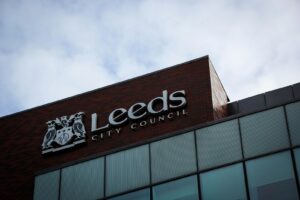Launching its first major campaign since he became chief executive of Locality, Tony Armstrong talks to New Start about the power of local, community rights and being optimistic
————————————————————————————
Q. Your first campaign, Keep it Local, launches next week and busts the myth that bigger is better in public services.
A. We published a report last year called Local by Default that showed that if you keep packaging up ever larger contacts and selling them to the highest bidder that’s not going to give you better and cheaper services. Services end up poorer and more expensive in the long run as you have to pick up the pieces and contract additionality. Many of Locality’s members are focused on the alternative. They are providing services that are locally based and closer to their communities and we know they work better at that level. As one member said: ‘We know the names of people in our patch so when they come through the door we just say ‘what’s up with you?’ and try to find a solution’. They see the person, listen to them and try to find appropriate solution. The big providers can’t do that. We are campaigning for public services to be commissioned and delivered at a neighbourhood level. We want public service contracts built around the needs of local communities; new laws to stop large organisations from running too many government contracts; and more commissioners trained in how to work well with community organisations. We want small, local organisations to be able to bid for public service contracts and we call on the next government to tell us when and how it will make this possible.
Q. Much of the government’s approach to services goes in the opposite direction.
A. For a commissioner who has to cut budgets the easiest thing for them to do is to focus on cost but it doesn’t achieve long-term savings. It’s very difficult to compare a local with an outsourced approach but we know that where a larger provider has taken a contract, smaller providers still have people coming through their doors asking for help because the service commissioned by the remote provider isn’t doing what it should be doing. The small providers are still picking up pieces and not getting paid. We need to ask national government to set the tone and encourage better commissioning practice.
So much money gets wasted creating specialist services and then setting the bar so high that they don’t cover peoples’ needs. Loneliness and isolation are priorities but councils want to set up specialist services when it would be cheaper to support one person in the neighbourhood to go around and check on people or to fund a befriending service.
An important part is showing that this works. We’ve started working with local authorities to look at this way of delivering. There’s increasingly a feeling in local government that salami slicing doesn’t work and councils are starting to think of whole new ways of redesigning services. They are coming to the table in partnership with our members with a genuine commitment to doing things differently.
Q. Do you have any good examples of services working better at a local level?
A. The chief executive of Wigan Council went around with social workers and realised their offer didn’t match up to what people were asking for. She has introduced a change progamme that is more flexible. So, for example, there was an older person suffering from isolation. Rather than directing him to a local day centre, they organised membership of a local club. Through talking to other people and getting a social life again, a lot of his other issues fell away. It’s the idea that when you listen to people you can design services that meet their needs.
Q. You have said you want to bring a more campaigning approach for your work at Locality.
A. Yes, our members have great models showing alternative ways of delivering public services and engaging communities and we can do more to shout about that and influence. There are so many issues that members are struggling with and policy barriers and we as the national body that represents them can do more in terms of suggestions for change and galvanising support.
Q. You’ve just been re-awarded the contracts for the community rights programmes.
A. Yes, we’ve been awarded the DCLG contracts for Community Ownership and Management of Assets, Our Place and First Steps, and Neighbourhood Planning and Community Buildings. Information, resources, advice, support and grants are available on www.mycommunity.org.uk.
Q. How successful have the community rights been?
A. Has it become a widespread movement with lots of communities jumping to take on these rights? No. But having those rights and the funding available to access them has made a huge difference in a large number of communities. It has sparked conversations that wouldn’t have happened before.
Right to Bid has been the right that has seen the most people going through. Right to Challenge is a bit oppositional and we’ve recommended that we should soften the language. The figures may not be overwhelming but they have led to a fundamental culture shift. There is now an expectation that communities can do these things and that local authorities should play ball.
Pubs and shops are the two sectors with the most traction in right to bid. Everyone understands the value of those assets to the community. Then we have more historic assets like Hastings Pier, which used community shares to finance it. We are keen to make sure all the different programmes are linked together as much as possible. If you take an Our Place approach, and neighbourhood planning and community organisers you get a critical mass of activity.
Q. What are the weaknesses in the rights?
A. One is that local authorities don’t have to provide information and if they are resistant to communities using these rights they can find a lot of ways to block it and hold things up. The onus is on the local authority to play ball and some don’t. But even if the local authority is oppositional communities can use that as a campaigning tool. In the legislation there is this responsibility. Also in neighbourhood planning it was always inevitable that we’d see more progress in parishes and leafy suburbs but we’re now seeing more progress outside that profile. We would like a greater focus on housing deprivation and on supporting housing development and economic growth.
Q. How is the Community Organisers programme going?
A. There’s an evaluation due out in April. In terms of outcomes we are on target with 500 going through the programme by summer and we’ve broken the volunteer target of 4500. In terms of impacts, it has given us a clear sense of the ways in which community organising can help community organisations to work. One of our trustees has been hosting a community organiser and it is changing the way it does some of its services and engages with communities. This is a 20-year-old organisation which is asking itself: ‘Are we really listening to people or are we doing things because we think we need to do them?’ We are mainstreaming that back into our members to make sure there are community organising approaches and will be talking about the themes in the next few months.
Q. What should councils do to engage with this agenda?
A. They should be engaging in partnership with community-led organisations to find solutions to public service delivery. If they actually engage with lots of our members they will tell you different ways to model and then it becomes about properly commissioning services not just procuring. Leeds is very good. It has a local authority that is very engaged with the sector. Our members Barca are working in partnership with the council on a number of different services and looking at models of service redesign.
Q. You worked in the Neighbourhood Renewal Unit under New Labour. How does Locality’s work carry on that vision?
A. I was there at start of NRU when it was formed. It was very exciting. There was a sense of overwhelming optimism that we could change the world. It’s sad that it came to an end well before long term ambition – that no one should be disadvantaged by where they live within 10-20 years – but it was wound down after six years as it was not making fast enough progress. There was a lot of money being spent and Treasury was getting very impatient to see specific outcomes after a few years. Community rights are an evolution of neighbourhood renewal policy from the early 2000s. Some of the lessons haven’t been learned and it’s frustrating when civil servants ask quite basic questions despite the evidence from huge regeneration programmes. You go round in circles but make progress each time. You can drive yourself mad being pessimistic. I choose to be optimistic.

















Leave a Reply